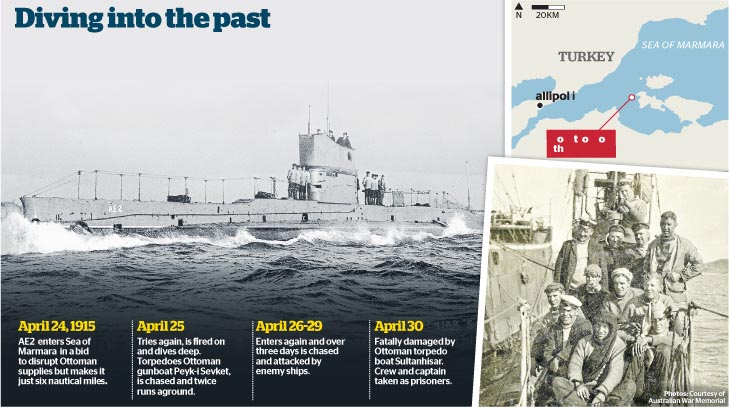
In June, one of the last time capsules from the First World War will be opened. Researchers drop a high definition camera into an Australian submarine that has sunk and its crew was taken as prisoners. The wreckage of the HMAS AE2 was discovered in 1998 and has been on the bottom of Turkey’s Sea of Marmara since it was scuttled by Commander HG Dacre Stoker during the Gallipoli campaign.
”We have effectively got an underwater time capsule that has not been opened since 1915,” said Roger Neill, the expedition’s science director.
Dr. Neill leads the automation and unmanned maritime systems unit at the Defense Science and Technology Organization. He said to WA Today that the project would not just survey and secure the site, but it will also install a cathodic protection system to survey the wreck and stop the metal from corroding. There will also be a marker buoy to protect it from shipping traffic and drag nets. The chief pilot of a remotely operated vehicle, Peter Graham, designed the hi-def camera that the DSTO Port Melbourne base uses. He has said the expedition would collect approximately a terabyte of data every day during the 17 day trip.
The project is estimated to cost up to $5 million. The plan is to film inside the submarine and it began in 2004. The years of preparation included the building of a replica submarine that used the original plans, to test camera equipment in Geelong’s Corio Bay. The task of filming inside a wreck that is 73 meters underwater is not an easy task. The research team had to custom design and build an underwater camera that would fit through the partially open hatch and move through the confining interior. Cabling also had to be wrapped in stainless steel coils to prevent it being damaged by aggressive European conger eels that live in the area and can weigh as much as 110 kilograms.
The chairman of the AE2 Commemorative Foundation and retired rear admiral, Peter Briggs, said the sea creatures became very territorial in the past. On a trip in 2007 to film the submarine’s exterior, some of the equipment resurfaced with scratch marks from eels teeth. Territorial sea-life aside, the submarine also has an unexploded and most likely loaded, torpedo on board.
If the torpedo has come in contact with water, the explosives will be degraded and may pose less of a risk. It is believed if the torpedo has remained sealed in the brass tube and is dry, the gun cotton explosives will be unstable and could be detonated with the slightest bump. ”If it goes off it would blow the back off the submarine and would kill any divers in the water,” Admiral Briggs said. Platforms will be attached to various parts of the submarine for divers to stand on to reduce movement and any activity on the stern will be minimized.
Since there is only one hatch open, it is likely that the water inside the submarine is the same water that flooded the submarine when it sank on April 30, 1915. This means there has been very little damaged caused by water movement. ”It’s probably going to have all the mugs, the tea, the cutlery, shoes and all the artefacts from the sailors,” Admiral Briggs said. ”It’s going to be quite something.”
